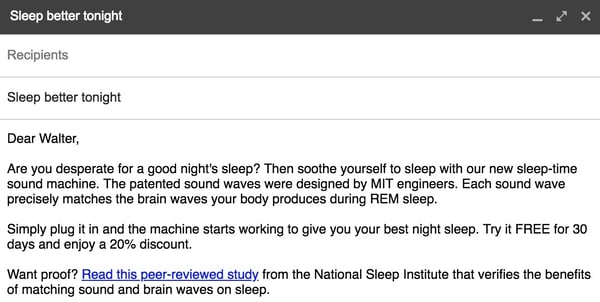Gary Bencivenga is a renowned direct response marketing expert who's worked at BBDO and Ogilvy & Mather. One of the key direct sales concepts he discusses in the persuasion equation: a set of easy-to-implement factors that go into any serious attempt to persuade a prospect to buy.
We call them the "six U's," and by keeping these sales best practices in mind when composing prospecting emails, you'll make your messaging better focused and more persuasive.
In short, your pitch needs to be:
- Urgent
- Useful
- Unique
- Ultra-specific
- User-friendly
- and provide unquestionable proof
How does that work in practice? Let's dive into the details.
1. Urgent
Most of us are happy to stick with the status quo unless we have a real need to change. No matter how great your products or services are, they probably aren't going to pique a potential customer's interest unless you can meet a genuine need that they have — and, given people's hesitation about trying new things, that need must be urgent.
Your messaging needs to identify the urgent needs your products meet, or at least to convince customers of the urgency of those needs. It doesn't have to be a hard sell: for instance, you could use something like, "Are you desperate for a good night's sleep?" (And honestly, most of us are.)
2. Useful
This is the starting point for many sales pitches — everyone wants to talk about how great and helpful their gear is! — but it properly comes second. Once you've established that your products are solving an urgent problem, you can start singing the praises of their usefulness.
Think of useful as the "then" to urgent's "if." Your messaging started by establishing what the problem is; now you need to explain that you're selling the solution.
For instance, you could say, “Then soothe yourself to sleep with our new sleep-time sound machine.”
Related: This Mistake Is Hurting Your Sales Team More You Think
3. Unique
Let's face it, though, you probably aren't the only company offering a purported solution to your potential customers' problem. If people are faced with a choice among a series of largely similar offerings, they'll generally go with the cheapest one — and that kind of race to the bottom is bad for your numbers.
Your messaging needs to play up the factors that differentiate your solution from your competitors, and how those factors relate to the urgent problems your potential customers face. Prospects need to know what they can get from you that they can't get anywhere else.
Continuing our example, you could say something like: “The patented sound waves were designed by MIT engineers.”
4. Ultra-specific
Part of the process of diving into the unique qualities of your products involves letting your prospects know exactly what it is you're putting on the table. Whether calling out specific features and benefits prospects will find useful or painting a picture of what it'll be like to use your product, the more specific you can be the better. Specifics beat generals every time.
In sales emails, you'll want to eschew vague buzzwords for concrete descriptions of exactly what your products do — and what they can do for your customers.
For instance, you could say, “Each sound wave precisely matches the brain waves your body produces during REM sleep.”
5. User-friendly
Remember what we said at the beginning about most of us being happy with the status quo? Even if we know we have problems, there's a resistance to jumping into something new — fear that a new product or service will have a learning curve that causes more problems than it solves. In a nutshell: remove objections.
Your messaging should emphasize how your product is easy enough to use or deploy that it won't disrupt prospects' day-to-day lives. This is also your chance to showcase discounts or special offers that will convince your potential customers to buy today.
For instance, “Simply plug it in and the machine starts working to give you your best night sleep. Try it FREE for 30 days and enjoy a 20% discount.”
6. Unquestionable Proof
Throughout this whole process, you need to be providing proof points to let your prospects know they can trust you. After all, the stereotype of the sleazy salesperson exists for a reason. You have to offer evidence to build trust. And make sure your evidence is believable.
You should be peppering your emails with proof that what you say is true: data, white papers, and impartial reviews can all help. And remember that a customer testimonial goes a long way toward building proof.
For instance, “Want proof? Read this peer-reviewed study from the National Sleep Institute that verifies the benefits of matching sound and brain waves on sleep.”
Figure 1. By following the six U's you can write persuasive sales emails in no time.

Persuasive Sales Emails That Close the Deal
With the six U's in mind, you're on your way towards connecting with — and convincing — your prospects. And with a customer relationship management (CRM) system like Salesforce.com, you can build the persuasion equation right into your automated workflows
Could you use sales support? A Prialto virtual sales assistant will make sure your data is organized to provide key insights and enhance decision-making.
Lastly, the Prialto Post has lots of great information on CRM, including tips on how a personal assistant can help you with your CRM strategy and how to increase open rates on Salesforce mass emails.
What You Should Do Now
If you need help with sales support, here are a few options to help you:
- Download our eBook "Spend More Time Selling with a Virtual Assistant" and get a better understanding of how a virtual assistant can handle tedious sales tasks to give sales leaders and teams more time to sell and take care of customers.
- Book a free consultation call with Prialto. We can help you regain more of your time to sell by offloading repeatable tasks to a fully managed virtual assistant. One of our experts will help you create a plan to delegate your tasks and we will even train your sales assistant for you.
- If you know someone else who’d benefit from sales support, share this post with them via email, LinkedIn, Twitter, or Facebook.
